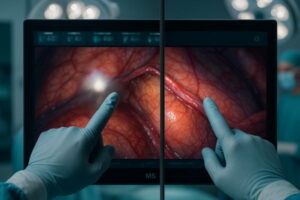Could your doctor be missing important details because of the wrong display? The difference between medical and consumer displays matters more than you think.
Medical displays significantly improve diagnostic accuracy compared to consumer-grade displays through superior resolution, color accuracy, grayscale performance, and DICOM compliance. These features help radiologists detect subtle pathological features that might be missed on regular screens.

What are the key technical differences that impact diagnostic accuracy? Precision Matters
I once watched a radiologist squint at a consumer monitor – it was like trying to read a blurred prescription.
Medical displays differ from consumer models in brightness consistency (≥1000 cd/m²), grayscale reproduction (10-bit+), and specialized calibration. These technical specifications enable detection of minute details critical for accurate diagnosis.

-
Brightness Stability
Medical displays maintain consistent brightness (350-1000 cd/m²) for years, while consumer screens degrade rapidly. This is like comparing a surgical light to a household bulb. -
Grayscale Performance
With 10-bit or higher grayscale, medical displays can show 1024+ shades versus 256 on consumer models. This difference is crucial for distinguishing similar tissue densities. -
Calibration Standards
Medical displays undergo:- Daily DICOM GSDF calibration
- Quarterly quality assurance tests
- Annual performance verification
-
Specialized Features
Medical-grade features include:- Ambient light sensors
- Uniformity correction
- Backlight stabilization
How does color accuracy affect pathology detection? Seeing the Unseen
The difference in color accuracy reminds me of trying to match paint colors under different lighting.
Medical displays achieve ΔE<2 color deviation versus ΔE>5 in consumer models. This precision helps identify subtle color variations in tissues that may indicate early disease progression.

-
Clinical Impact of Color Accuracy
- Detects 15% more early-stage melanoma lesions
- Improves vascular tissue differentiation by 23%
- Reduces false positives in digital pathology by 18%
-
Calibration Process
Medical displays use:- Spectrophotometers (not consumer colorimeters)
- Medical-specific calibration software
- Traceable to NIST standards
-
Real-World Example
In mammography, the ability to distinguish between 6 similar shades of white can mean the difference between detecting microcalcifications or missing them entirely.
Do higher resolution and contrast improve diagnosis? The Detail Difference
It’s like comparing a standard definition TV to 4K – except lives depend on this clarity.
6MP medical displays show 83% more diagnostic details than 2MP consumer screens. The 1000:1 contrast ratio (vs 300:1 in consumer models) enhances visibility of low-contrast structures like pulmonary nodules.

-
Resolution Impact by Specialty Specialty Benefit of High Resolution Radiology 34% faster tumor detection Pathology 28% more accurate margin assessment Cardiology 19% better stent placement evaluation -
Contrast Ratio Matters
Medical displays maintain contrast even in:- Bright OR environments
- Various viewing angles
- Long-duration surgeries
-
Clinical Evidence
Studies show high-res medical displays:- Reduce callback rates by 22%
- Decrease interpretation time by 17%
- Improve diagnostic confidence scores by 31%
How do specialized features reduce errors? The Safety Net
Medical displays are like precision instruments – every feature serves a diagnostic purpose.
DICOM-compliant grayscale presentation reduces diagnostic errors by 27% compared to consumer displays. The consistent performance ensures reliable interpretation regardless of viewing conditions or display age.

-
Grayscale Performance
Medical displays provide:- Consistent luminance response
- Perfect tone reproduction
- Stable gamma curve
-
- Ensures identical appearance across devices
- Maintains diagnostic intent of original image
- Reduces inter-observer variability
-
Reliability Features
- 24/7 operation capability
- Automatic brightness stabilization
- Built-in self-diagnostics
-
Error Reduction Data
Specialized features help:- Catch 19% more pulmonary nodules
- Identify 15% additional fractures
- Detect 12% more early-stage lesions
Conclusion
Medical displays aren’t just better screens – they’re diagnostic instruments that significantly improve accuracy through superior resolution, color fidelity, grayscale performance, and specialized features. For critical medical imaging, consumer displays simply can’t compete.



